Metaverse Statistics By Market Capitalization, Revenue, Companies, Users, Meta Platform Income and Facts
Updated · Nov 18, 2024

Table of Contents
- Introduction
- Editor’s Choice
- Metaverse Market Size Forecast
- The Market Capitalization of Metaverse
- Metaverse Adoption Statistics
- Top Sectors Investing in the Metaverse
- Metaverse Market Opportunity
- Users of Virtual Platforms
- Customer Familiarity With Metaverse
- Advantages of Using Metaverse
- Dangers of Metaverse
- Reason For Joining Metaverse
- Popularity of Metaverse Applications
- Top Business Sectors in Metaverse
- Company Presence in The Metaverse
- Meta Platform Income and Revenue Generation
- Metaverse Expectations, According to Companies
- Top Tech Experts View the Current Metaverse
- Metaverse Gaming Statistics
- Conclusion
Introduction
Metaverse Statistics: The metaverse, regarded as the next evolution of the internet, is a convergence of the physical and digital worlds. It enables users, represented as digital avatars, to interact in a variety of settings, such as workspaces, concerts, sporting events, or even virtual retail spaces. Accessible through virtual reality (VR) headsets, augmented reality (AR) glasses, smartphone applications, and other devices, the metaverse is reshaping how individuals and communities connect. Coined by Neal Stephenson in his 1992 science fiction novel Snow Crash, the term “metaverse” describes a virtual universe that integrates seamlessly with everyday life.
Facebook’s rebranding as Meta Platforms in 2021 signaled a major corporate shift toward metaverse development, with the company investing USD 10 billion into its Reality Labs division in the same year. Reality Labs generated USD 2.3 billion in revenue in 2021, reflecting the growing interest in metaverse-related technologies. Other global tech giants, including Microsoft, Roblox, and Epic Games, have made significant investments in the metaverse, leveraging advancements in 5G, artificial intelligence (AI), and cloud computing to drive innovation.
Editor’s Choice
- Web 2.0 metaverse leads market capitalization at $14.8 trillion.
- At 33% digital economy adoption, the metaverse market opportunity could reach $12.46 trillion.
- Facebook dominates virtual platforms with 2.97 billion users.
- Age group 35-54 shows highest metaverse familiarity at 18%.
- 39% of users value metaverse for overcoming real-world obstacles.
- 47% of respondents consider addiction to simulated reality as the biggest danger.
- 52% join Metaverse for work possibilities.
- December 2021 saw peak Metaverse app launches with 30 new applications.
- Computer and IT sector leads metaverse investment at 17%.
- 05% of all businesses have a metaverse presence.
- Meta Platform’s 2023 revenue reached $134,902 million.
- Virtual assets in metaverse expected to reach $400 billion by 2025.
- The gaming sector is projected to reach $300 billion by 2025.
- Educational applications are projected to reach $60 billion by 2025.
- NFT sales exceeded $2 billion in 2022.
Metaverse Market Size Forecast
- The Global Metaverse Market is projected to grow from USD 94.1 billion in 2023 to USD 2,346.2 billion by 2032, with a compound annual growth rate (CAGR) of 44.4% during the forecast period from 2024 to 2033.
![]()
- The Virtual Reality Headset Market is expected to increase from USD 13 billion in 2023 to USD 121.9 billion by 2032, reflecting a CAGR of 29.1%.
- The Global Extended Reality (XR) Market is anticipated to grow from USD 49.6 billion in 2023 to USD 519.5 billion by 2032, at a CAGR of 30.8% from 2024 to 2033.
- The Global Mixed Reality Market is forecasted to expand from USD 52.6 billion in 2023 to USD 1,224.0 billion by 2032, with a CAGR of 43.2%.
- The Immersive Reality Technologies market is set to grow from USD 90.8 billion in 2023 to USD 780.4 billion by 2033, achieving a CAGR of 24% from 2024 to 2033.
- The Augmented Reality Market is expected to grow from USD 29.6 billion in 2024 to USD 591.7 billion by 2033, with a steady CAGR of 39.5%.
- The combined Augmented Reality and Virtual Reality Market is projected to increase from USD 34.8 billion in 2023 to USD 106.2 billion by 2033, with a CAGR of 11.8% from 2024 to 2033.
- In 2022, the hardware segment dominated the market with over 39% of the market share.
- The desktop segment captured more than 42% of the market in 2022.
- The Virtual Reality and Augmented Reality segment held a significant position, commanding more than 36% of the market share.
- The gaming segment was a key player in 2022, securing over 27% of the market share.
- The BFSI segment also accounted for more than 27% of the market in 2022.
- North America led the Metaverse market in 2022, holding over 43% of the market share, with revenues totaling USD 13 billion.
- Around 53% of businesses investing in the metaverse have allocated resources to cryptocurrencies, showcasing a strong belief in digital currencies.
- Investments in non-fungible tokens (NFTs) have been made by 44% of businesses, highlighting the significance of digital assets.
- Approximately 40% of investors have focused on the work environment and remote working sectors, reflecting the growing importance of virtual collaboration tools.
- About 30% of investments have been directed towards branding and positioning efforts in the metaverse.
- Around 27% of businesses have invested in digital product purchasing, signaling a shift towards virtual commerce.
- The gaming industry and product creation have attracted investments from 24% of businesses, emphasizing interactive and creative applications.
- Virtual real estate has drawn interest from 18% of investors, demonstrating the potential of the virtual property market.
- The entertainment sector has captured the attention of 15% of investors, underlining its potential for immersive experiences.
The Market Capitalization of Metaverse
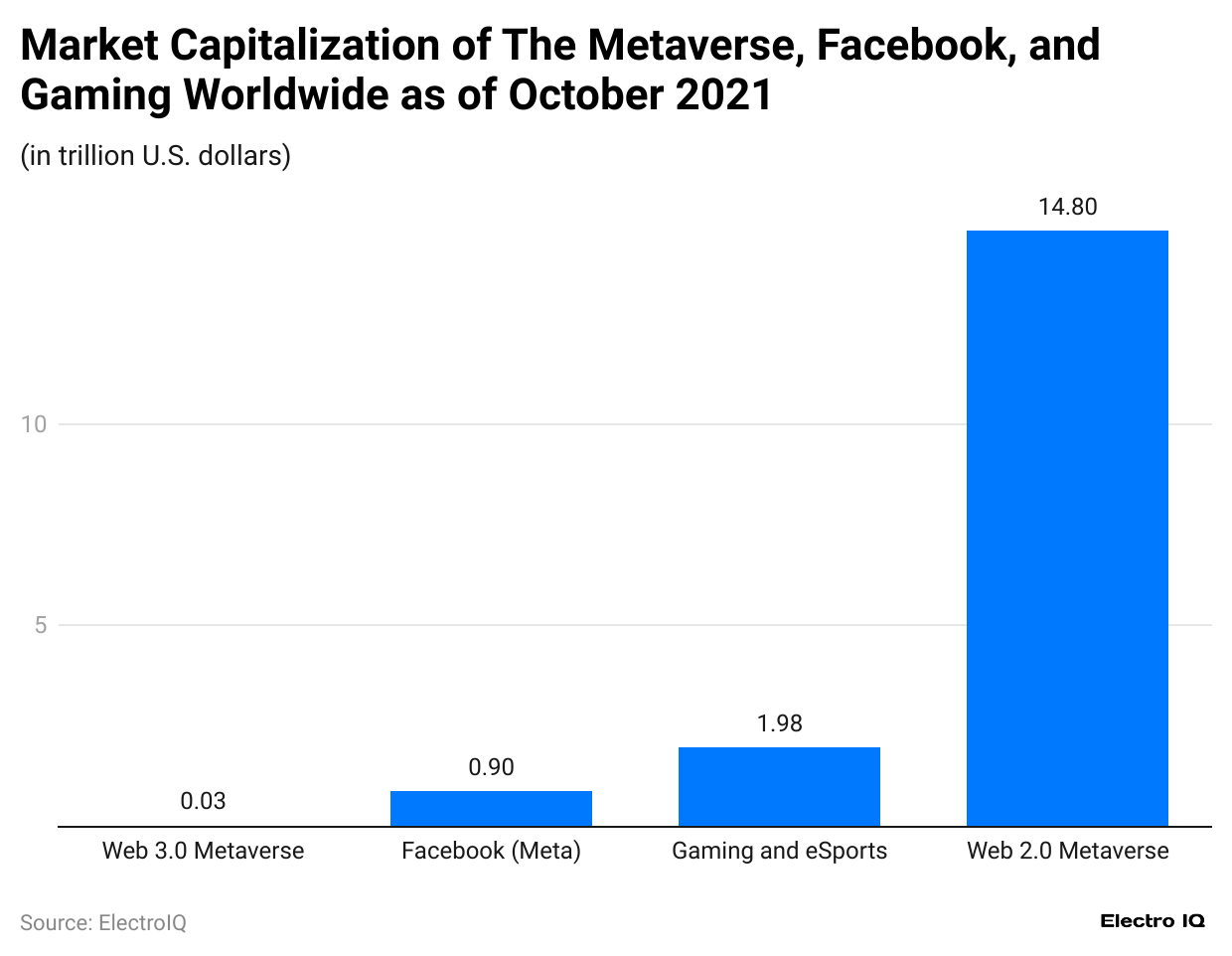
(Reference: statista.com)
- Metaverse Statistics show that market capitalization can be categorized into eSports and Web Gaming 2.0 Metaverse 3.0 Facebook (Meta) Metaverse Web.
- Web 2.0 metaverse had a $14.8 trillion market capitalization, followed by Web 2.0 Metaverse with $2 trillion, Web 3.0 Metaverse with $0.03 trillion, Facebook (Meta) with $0.9 trillion, Gaming and eSports with $1.98 trillion.
Metaverse Adoption Statistics
- A Gartner report predicts that by 2026, 25% of the global population will spend at least one hour daily in the metaverse, engaging in activities such as work, shopping, social media, and entertainment. Additionally, at least 30% of organizations are expected to offer products and services within the metaverse.
- In a global study covering 29 countries, 66% of respondents believe that Extended Reality (XR) will have the most significant impact on virtual learning. This is followed by entertainment in Virtual Reality (VR) at 64%, virtual work environments at 62%, enhanced gaming at 60%, virtual socialization at 59%, digital health resources at 59%, trading of digital assets at 52%, and virtual travel and tourism at 48%.
- A survey of over 4,000 U.S. adults conducted by Morning Consult found that 50% identified lower-priced VR headsets as the primary driver for metaverse adoption. Other key factors include an increase in available content (40%), adoption by family and friends (39%), government regulations (36%), and workplace use (30%).
- According to Tidio, approximately 60% of gamers have engaged in virtual experiences within the metaverse that are not directly related to gaming.
- Additionally, a survey by Tidio revealed that 52% of respondents plan to join the metaverse for work-related reasons. Other motivations include art and live entertainment (48%), investment opportunities (44%), education (40%), online dating and socializing (32%), gaming (29%), and adult entertainment (18%).
| Primary Reasons for Joining the Metaverse | Share of respondents |
| Work possibilities | 52% |
| Art and live entertainment | 48% |
| Money investment | 44% |
| Education | 40% |
| Online dating and socializing | 32% |
| Gaming | 29% |
| Adult entertainment | 18% |
Top Sectors Investing in the Metaverse
- Computer and IT sectors lead metaverse investments, making up 17% of the total.
- Education accounts for 12% of metaverse investments, with applications like flight simulation, anatomy and surgery training, and digital learning platforms.
- The finance sector contributes 11% to metaverse investments.
- Marketing and advertising sectors allocate 10% of investments in the metaverse.
- Medical and health industries dedicate 9% of investments to metaverse-related initiatives.
- Technology and innovation sectors represent 7% of total investments in the metaverse.
- Travel and hospitality sectors account for 6% of the investments directed toward the metaverse.
- Both construction and transport sectors each contribute 5% to metaverse investments.
- Customer service allocates 4% of its resources to metaverse-related developments.
| Sector | Metaverse investments |
| Computer and IT | 17% |
| Education | 12% |
| Finance | 11% |
| Marketing and advertising | 10% |
| Medical and health | 9% |
| Technology and innovation | 7% |
| Travel and hospitality | 6% |
| Construction | 5% |
| Transport | 5% |
| Customer service | 4% |
Metaverse Market Opportunity
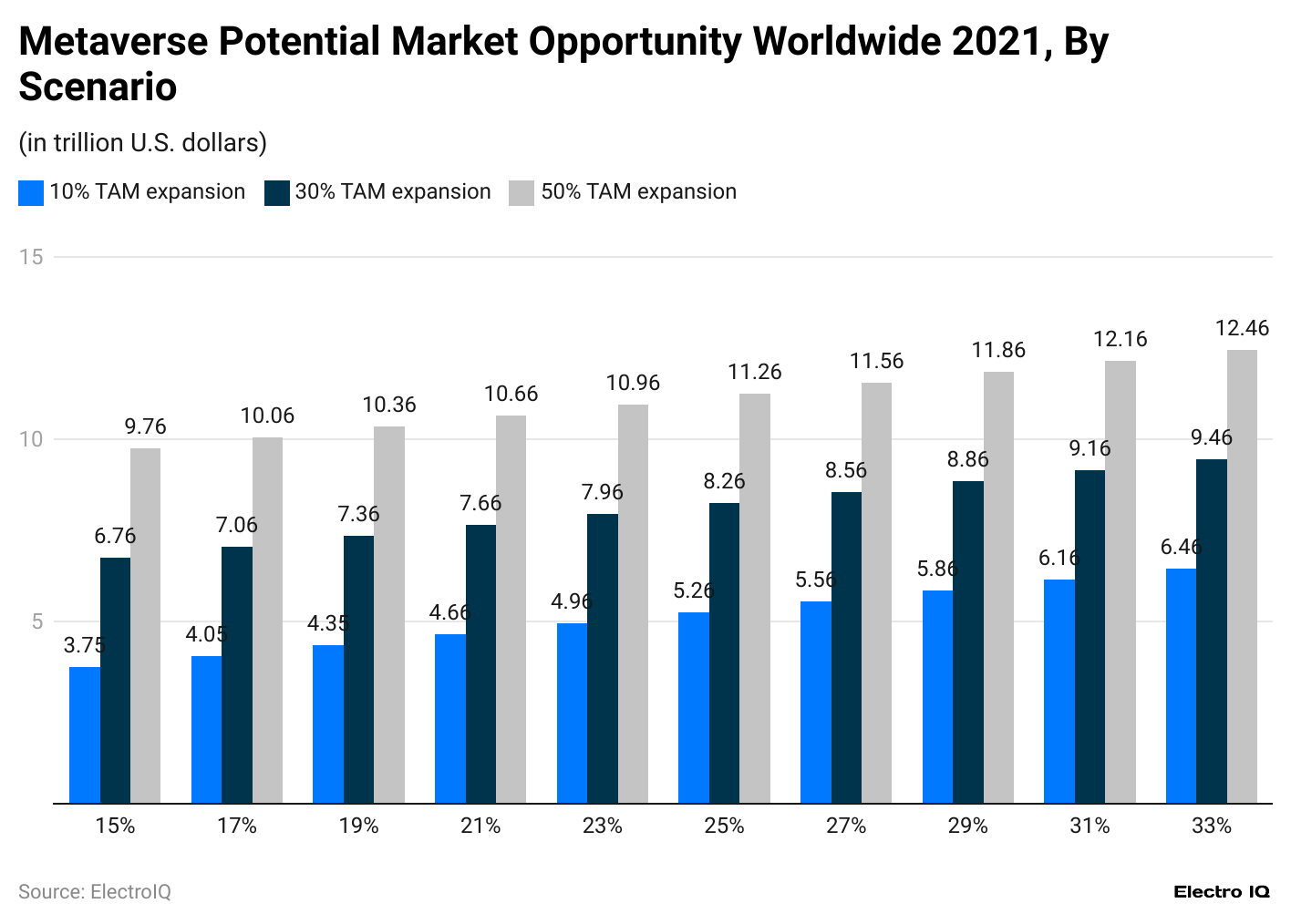
(Reference: statista.com)
- Metaverse Statistics show that potential market opportunity for the metaverse worldwide shows significant growth depending on the percentage of the digital economy shifting toward it. Higher adoption percentages correlate with larger market opportunities, potentially reaching $12.46 trillion.
- At 15% digital economy adoption, the market opportunity stands at $3.75 trillion, increasing steadily to $6.16 trillion at 33%. There is $4.05 trillion with 15% adoption; this scenario sees potential growth reaching $6.46 trillion by 33%. The highest growth potential in this scenario reaches $12.46 trillion with 33% adoption, starting at $6.76 trillion for 15%.
Users of Virtual Platforms
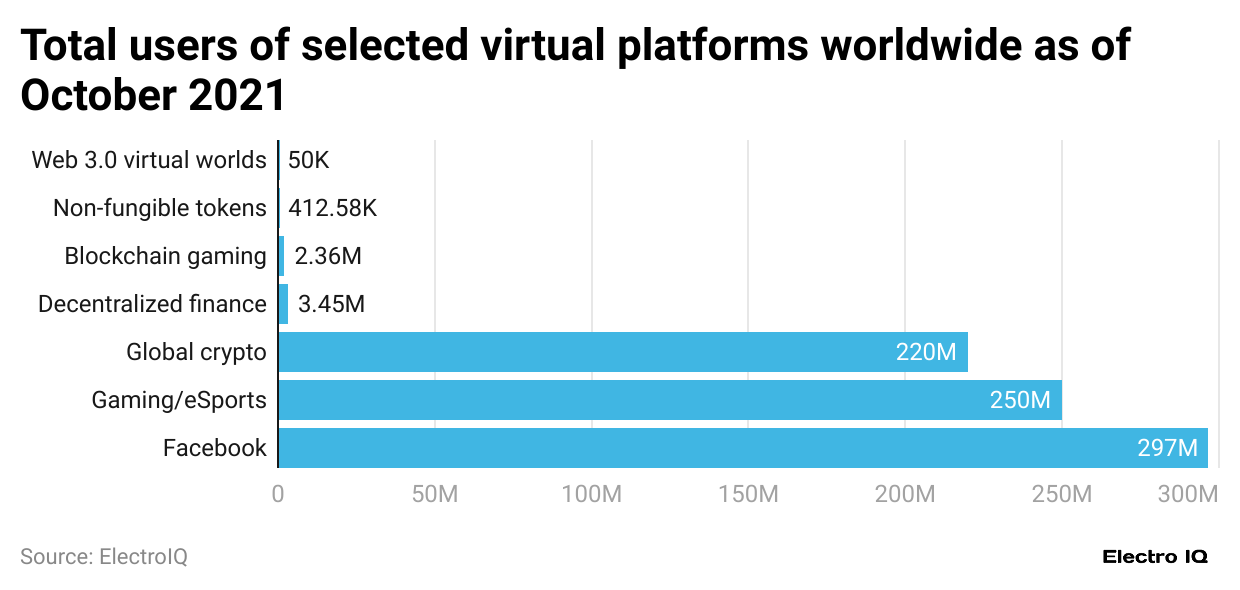
(Reference: statista.com)
- Metaverse Statistics show that Facebook has the largest user base among the selected virtual platforms, with 2.97 billion users, indicating its dominant position in the virtual platform space.
- Global Crypto has a substantial user base with 220 million users, showcasing the growing interest in cryptocurrencies worldwide.
- Gaming/eSports has 250 million users; this sector shows significant engagement, reflecting the popularity of gaming and esports activities globally.
- Web 3.0 Virtual Worlds has the smallest user base with only 50,000 users, suggesting that Web 3.0 virtual worlds are still in the early adoption phase compared to other platforms.
Customer Familiarity With Metaverse
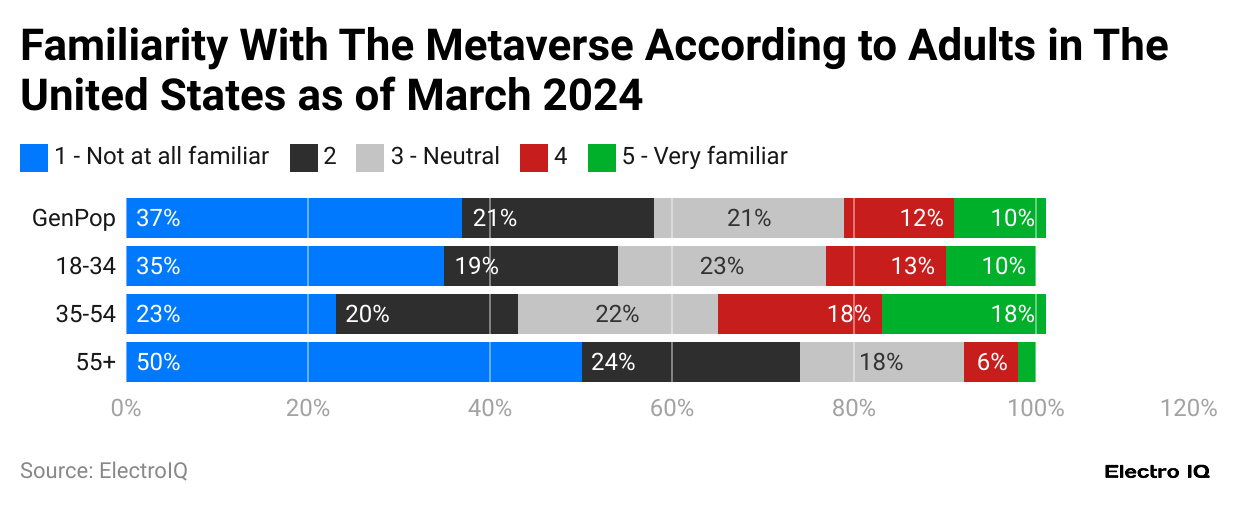
(Reference: statista.com)
- Metaverse Statistics show overall familiarity among US users with metaverse changes according to age.
- The highest familiarity tends to be in the age group 35 – 54, with 18% familiarity among respondents.
- The lowest amount of familiarity is seen among respondents ages 55+.
Advantages of Using Metaverse
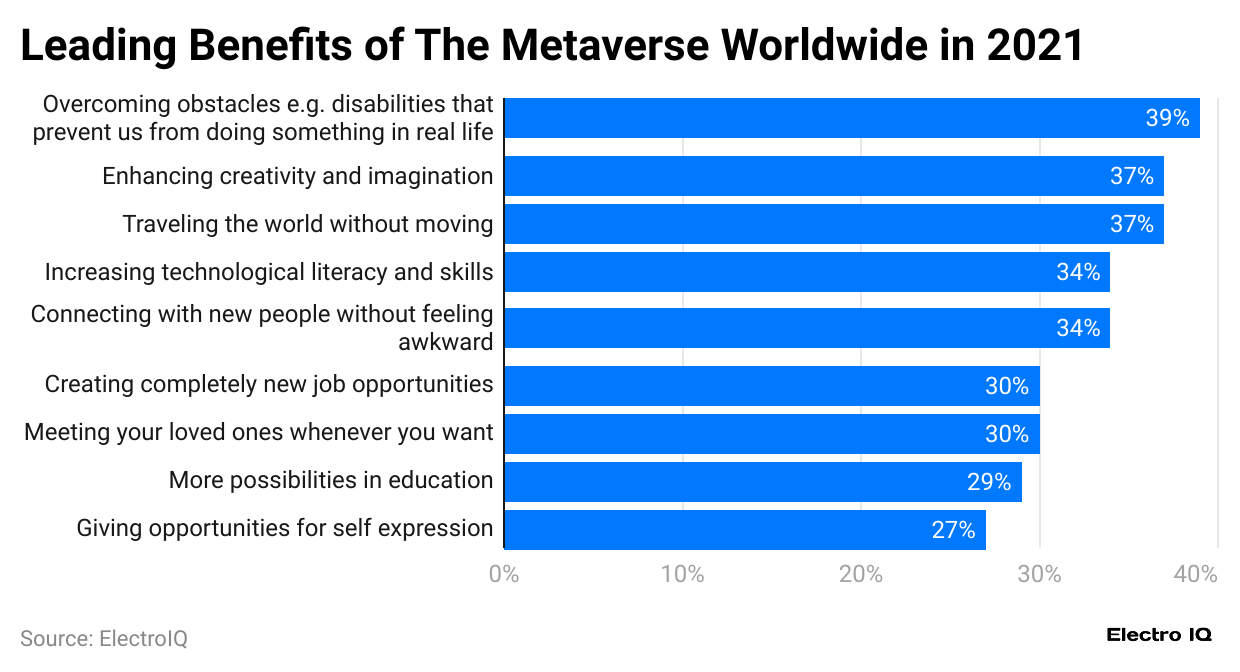
(Reference: statista.com)
- Metaverse Statistics show that this technology is perceived as a powerful tool for overcoming real-world limitations and expanding personal experiences, with its potential benefits recognized across diverse areas such as creativity, accessibility, and social interaction.
- Overcoming Obstacles is the most valued benefit of the metaverse’s ability to help people, according to 39% of respondents.
- Giving opportunities for self-expression is the relatively least favored benefit of the metaverse, according to 27% of respondents.
Dangers of Metaverse
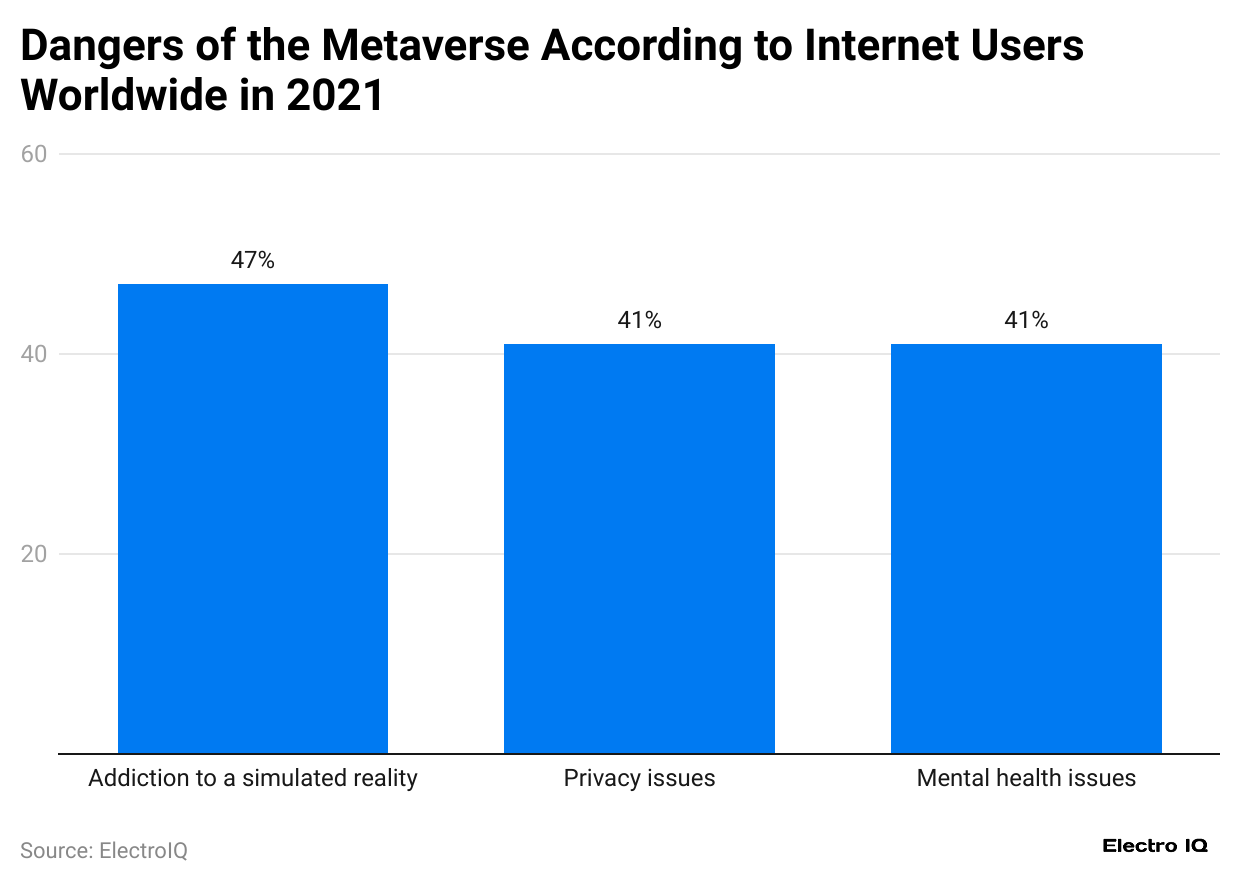
(Reference: statista.com)
- Metaverse Statistics show that Addiction to a simulated reality, Privacy issues, and Mental health issues are different dangers of the metaverse.
- Addiction to stimulated reality has the highest danger, with 47% of respondents, followed by Privacy issues and Mental health issues with 41% of respondents.
Reason For Joining Metaverse
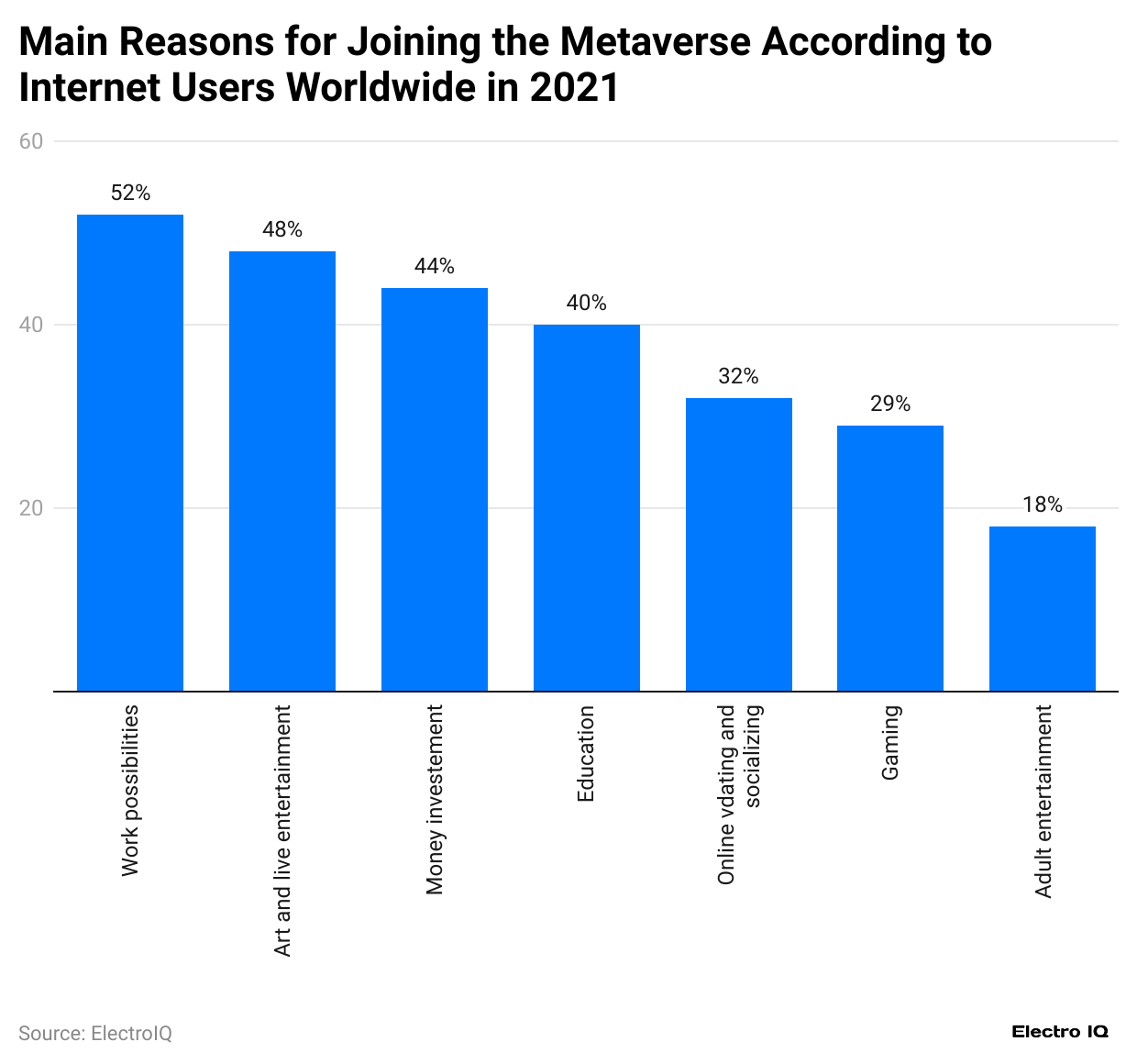
(Reference: statista.com)
- Metaverse Statistics show that primary motivations for joining the metaverse are centered around work opportunities and entertainment, with a significant portion of respondents showing interest in professional and social activities within the virtual space.
- Work Possibilities provided the most common reason for joining the metaverse among 52% of respondents.
- In contrast, 18% of respondents found adult entertainment to be the reason for joining the metaverse, which is also the least reason for joining the metaverse.
Popularity of Metaverse Applications
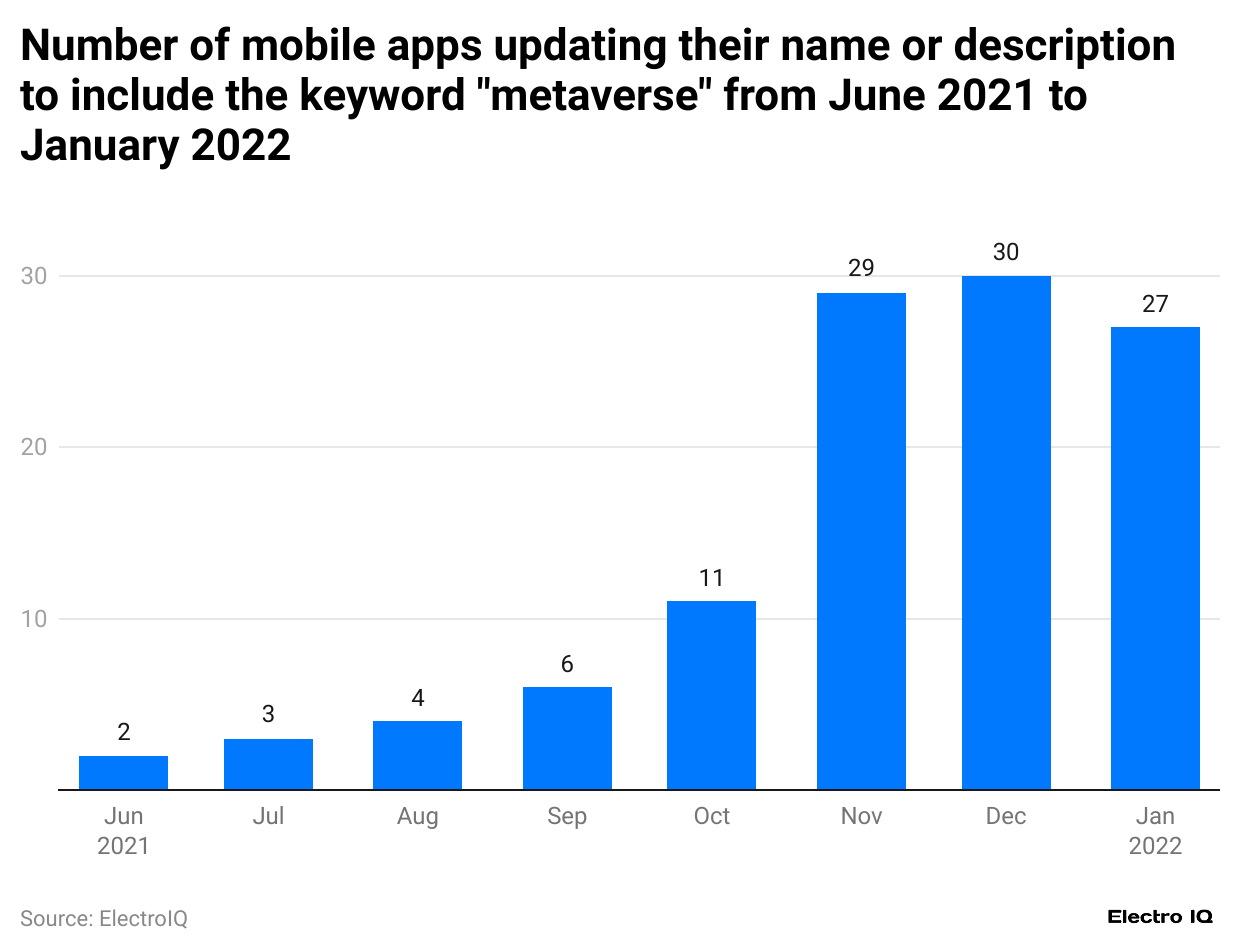
(Reference: statista.com)
- Metaverse Statistics show that the number of mobile applications using Metaverse has been consistently increasing.
- Between Jun 2021 and Jan 2022, the highest number of metaverse apps was 30 in December 2021, while the lowest was 2 in June 2021.
- As of Jan 2022, there are 27 metaverse applications available.
Top Business Sectors in Metaverse
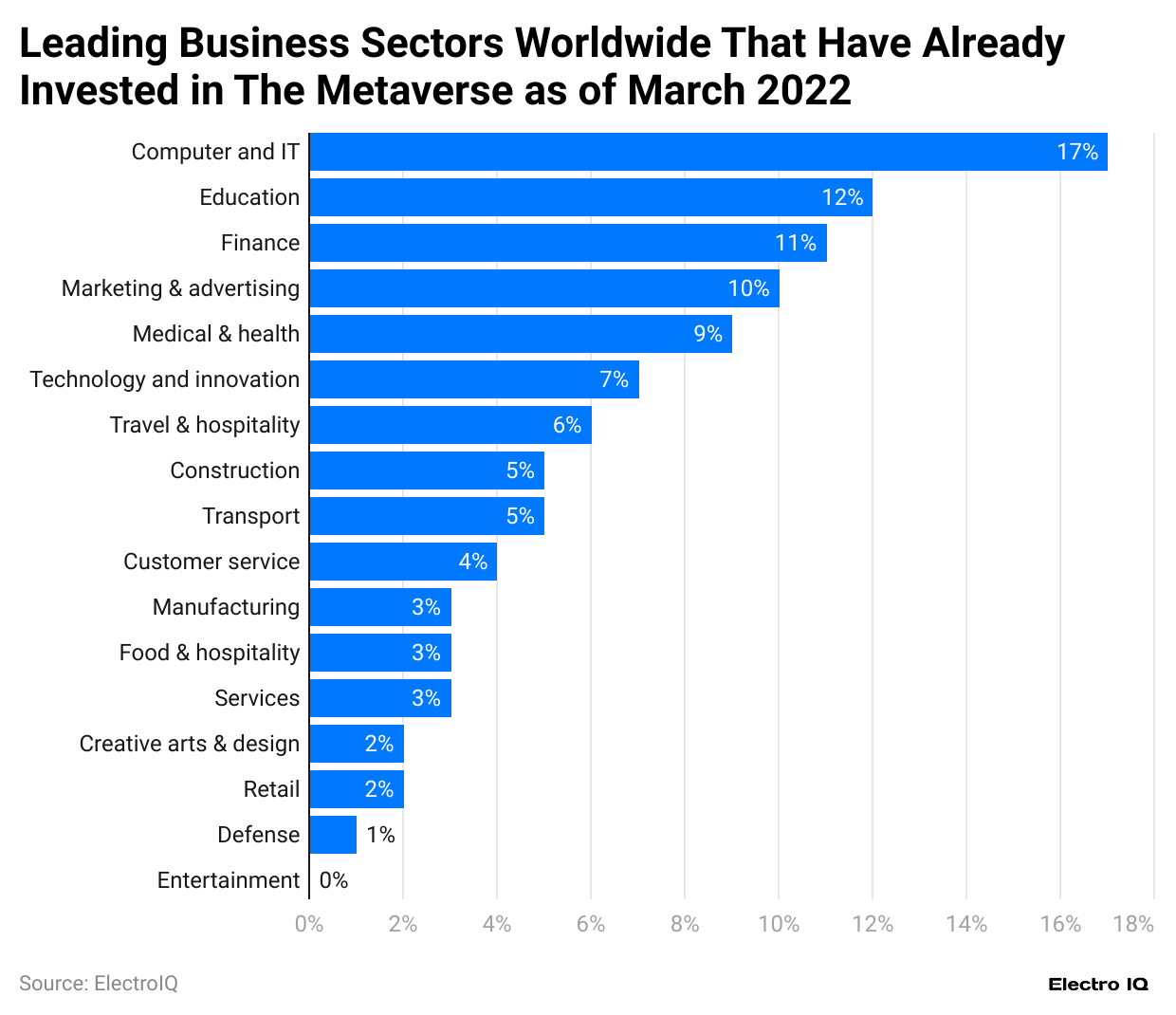
(Reference: statista.com)
- Metaverse Statistics show that computer- and IT-sector companies have made the highest investment in the metaverse, with 17%.
- The next five investments are made in the following sectors: Education at 12%, Finance at 11%, Marketing & advertising at 10%, Medical & health at 9%, Technology and innovation at 7%, and computer- and IT at 12%.
Company Presence in The Metaverse
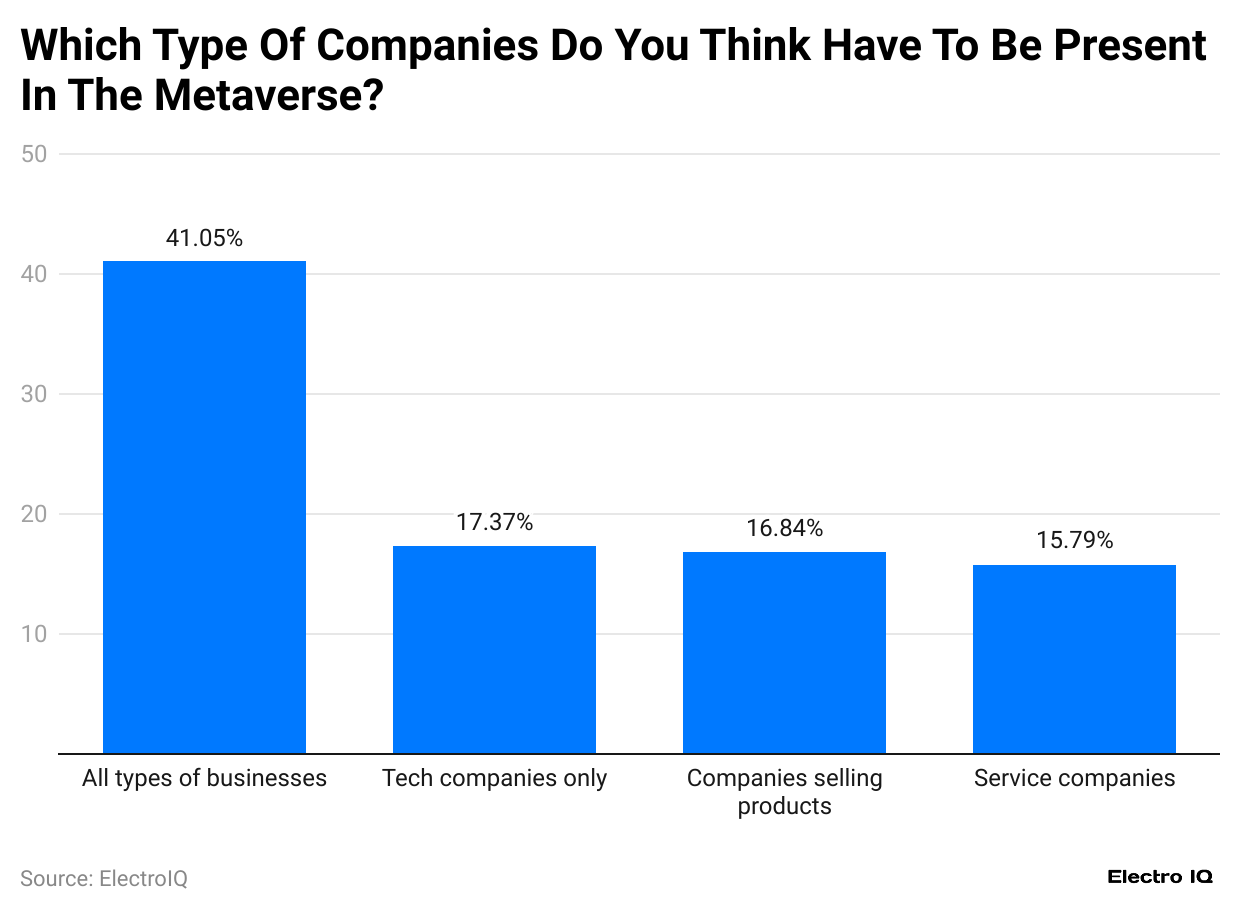
(Reference: statista.com)
- Metaverse Statistics show that 41.05% of all businesses are in the metaverse.
- 3% of tech companies, 16.84% of companies selling products, and 15.79% of service companies have a presence in the metaverse.
Meta Platform Income and Revenue Generation
(Reference: statista.com)
- Metaverse Statistics show a consistent increase in Meta Platforms' annual revenue from 2007 to 2023, with revenue growth significantly outpacing net income. While net income also increased over time, it experienced more fluctuations, particularly after 2018.
- As of 2023, the revenue of the meta platform is $134,902 million, and net income is $39,098 million.
Metaverse Expectations, According to Companies
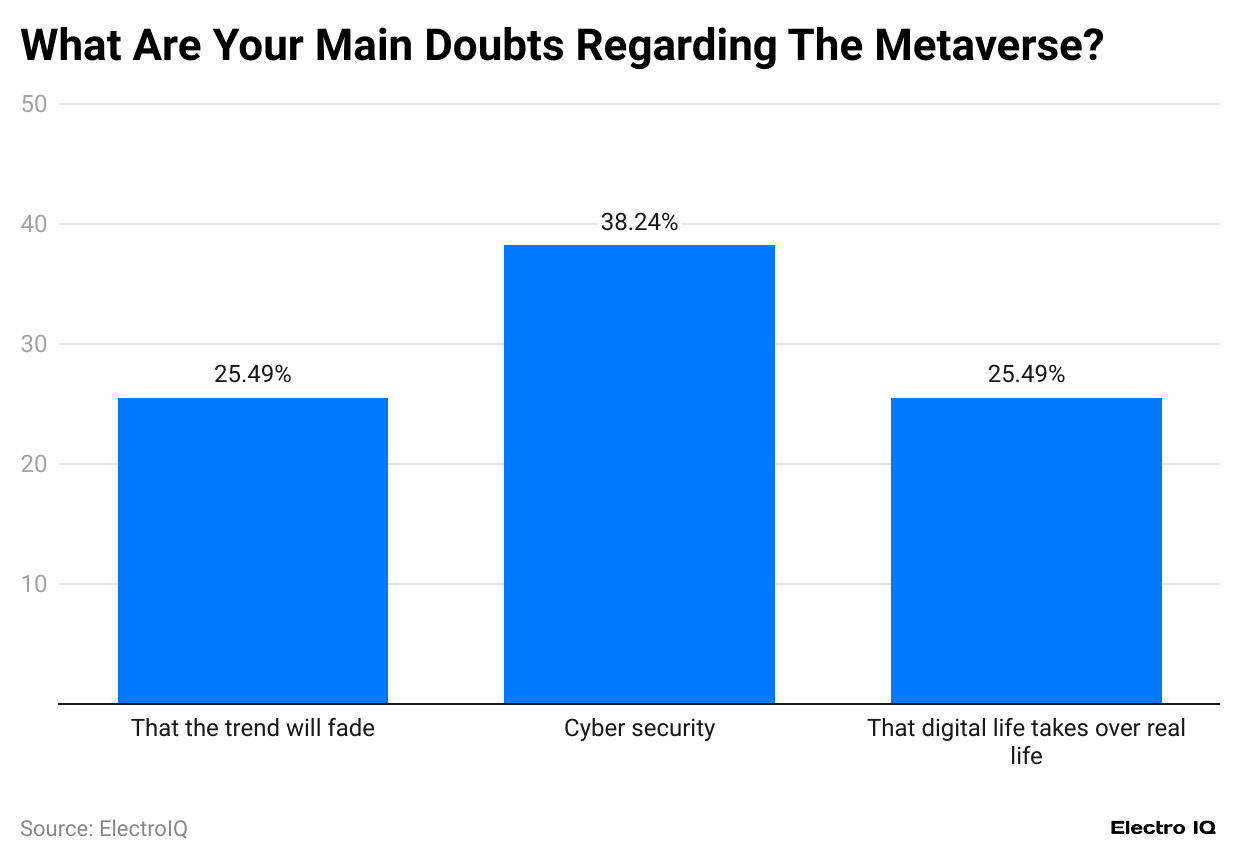
(Reference: statista.com)
- Metaverse Statistics show that there are different doubts among companies regarding metaverse.
- 24% of companies have the highest number of issues among respondents, followed by 25.49% of respondents assuming that this trend will fade and digital life will take real life.
Top Tech Experts View the Current Metaverse
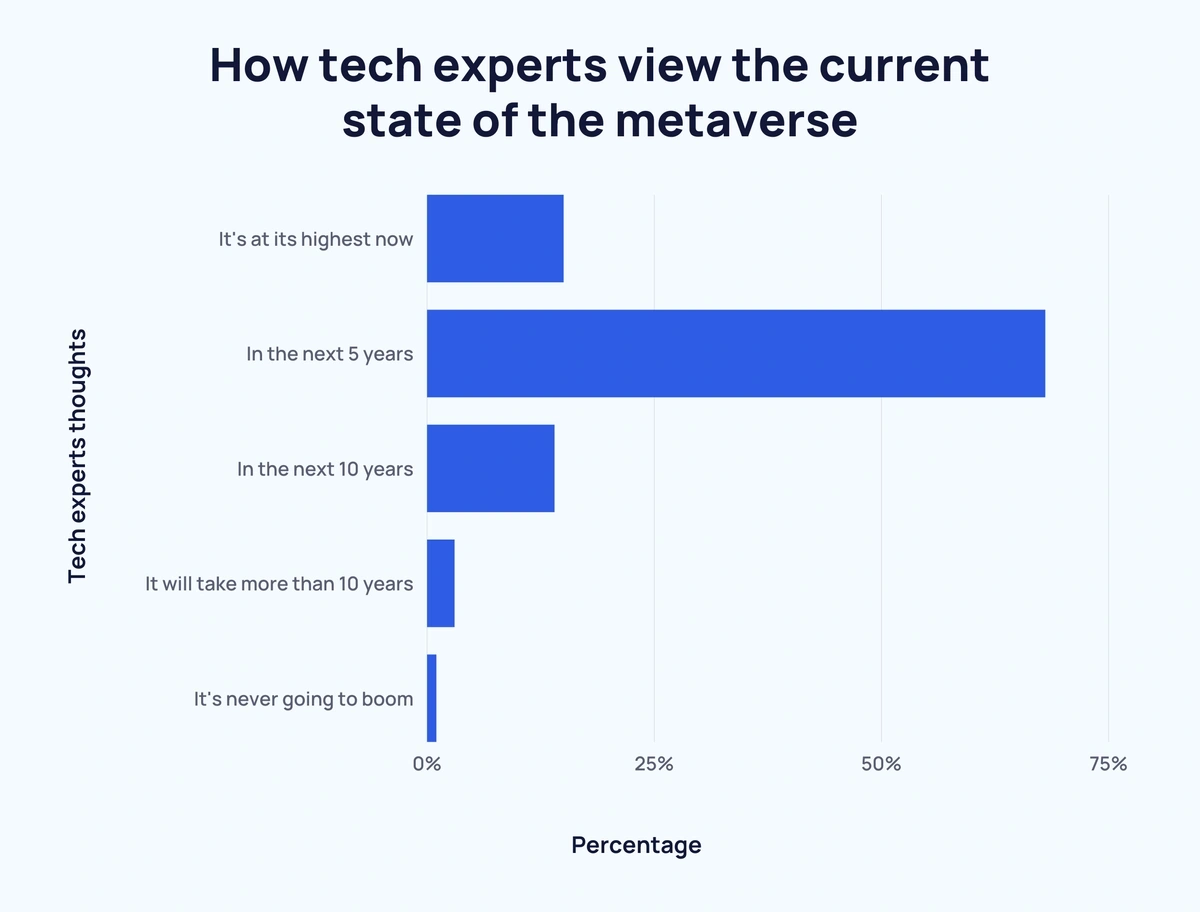
- 68% of tech experts believe the metaverse will experience rapid expansion within the next 5 years.
- 15% of tech experts think the metaverse is currently at its peak.
- 14% of tech experts anticipate the metaverse will take off within the next 10 years.
- 3% of tech experts predict it will take more than 10 years for the metaverse to start booming.
- 1% of tech experts think the metaverse will never boom.
| Tech Experts Thoughts | Percentage |
| It's at its highest now | 15% |
| In the next 5 years | 68% |
| In the next 10 years | 14% |
| It will take more than 10 years for this technology to start booming | 3% |
| It's never going to boom | 1% |
Metaverse Gaming Statistics
- The metaverse gaming market is projected to grow by 38% annually through 2027, according to Global Market Estimates.
- Nearly USD 20 billion is expected to be invested in AR and VR gaming technology by the end of 2024, making up 62% of all AR and VR investments, with other applications such as training, industrial maintenance, and retail lagging behind.
- Roblox is the most popular metaverse game, with 55 million active daily players, followed by games like VRChat, Horizon Worlds, Rec Room, Neos VR, Altspace VR, Chillout VR, Sansar, and Oasis VR.
- Approximately 59% of metaverse gamers are male, with an average age of 27, which is younger compared to the broader gaming market.
- The age distribution of metaverse gamers shows 38% are aged 10-20, 36% are aged 21-35, 22% are aged 36-50, and 4% are aged 51-60.
- Cryptocurrency tokens and NFTs are anticipated to be significant growth drivers in the metaverse gaming market alongside advancements in AR and VR technology.
- By the end of 2024, the gaming industry is set to lead AR and VR investment, highlighting its dominance in immersive technology development.
Conclusion
The metaverse represents a transformative digital frontier that continues to evolve and expand across multiple sectors. Metaverse Statistics demonstrate a clear shift toward virtual interactions, with strong adoption rates in professional, educational, and entertainment spheres. While work possibilities lead user motivation at 52%, the platform's versatility extends to entertainment, education, and social interaction, creating a comprehensive digital ecosystem.
As we look toward 2025, the metaverse is positioned to revolutionize how we work, learn, and interact. With projected market opportunities reaching trillions and increasing technological advancement, the metaverse is a pivotal force in shaping the future of digital interaction and economic activity.
Sources
FAQ.
A virtual universe blends physical and digital realities, focusing on social and economic connections.
Facebook leads with 2.97 billion users on its virtual platform.
52% of users join for work possibilities and professional opportunities.
47% of users worry about addiction to simulated reality.
The 35-54 age group shows the highest familiarity at 18%.
The metaverse market is expected to reach $800 billion by 2024.
The computer and IT sector leads with 17% of investments.
41.05% of all businesses have established a presence in the metaverse.
Virtual assets in the metaverse are projected to reach $400 billion by 2025.

Rohan Jambhale is a senior editor at Smartphone Thoughts. He specializes in digital marketing, SEO, and social media optimization. Rohan excels in creating and editing detailed articles, ensuring they are packed with accurate statistics that readers find valuable. As a senior editor, he meticulously reviews and verifies the quality of content from various writers before it goes live. Additionally, Rohan designs infographics to accompany the statistics, making the information more understandable and engaging. His dedication ensures that Smartphone Thoughts delivers high-quality and informative content to its readers.


